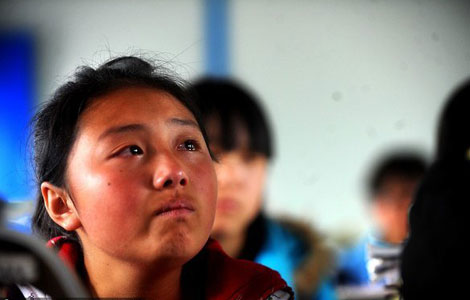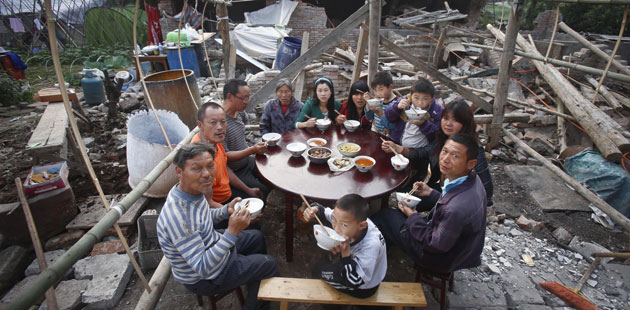Citizens' right to good eco-environment is further secured. From 2008 to 2012 China dredged 24,500 km of key medium and small rivers, and increased the water-saving irrigation area by 7.7 million hectares (ha). In 2011 and 2012, the central government earmarked a special fund of 2.4 billion yuan for supporting a pilot program for a balanced lake eco-system, increasing the initial eight lakes to 27 now. So far, 80,000 mu (about 5,333 ha) of wetlands have been restored and 160,000 mu (about 10,667 ha) of forest-covered area has been created in the first eight lakes of the pilot program, effectively improving the water quality and self-recovery capability of these lakes. China implements in full a mechanism for subsidization for grassland eco-system protection. In 2011 and 2012, the central coffers allocated 28.6 billion yuan to subsidize a grazing ban on 1.23 billion mu (about 82 million ha) of pastureland and to reward efforts to achieve a balance between the forage yield and number of animals on 2.605 billion mu (about 174 million ha) of pastureland. By 2012, the vegetation coverage of grasslands across China had reached 53.8 percent, an increase of 2.8 percentage points over 2011, and the fresh grass yield of natural pastures amounted to 1.05 billion tons, an increase of 4.7 percent over 2011. The comprehensive conservation of water and soil has been further improved. From 2008 to 2012 an additional 29.53 million ha. of land was planted with trees, desertification was halted on 11.96 million ha of land, soil erosion on 246,000 sq km of land was brought under control, and a total of 180,000 sq km of land was improved. The number of key counties halting stony desertification was increased to 300, and the project to control the sources of the sandstorms that hit Beijing and Tianjin was extended to include 138 counties in six provincial-level regions. The pace is accelerated in key regional eco-system development projects, such as the comprehensive treatment plan of the Tarim, Heihe and Shiyang river basins and the plan of water resources sustainable utilization for Beijing. The integrated project for rational utilization of water resources and ecological protection in Dunhuang has been going into full swing. China's urban green areas now total 2,242,861 ha., covering 39.22 percent of the total urban land, with the per-capita green area in public parks being 11.8 sq m. China now has 10,780 public parks, among which 63 are key national ones and 45 national urban wetland parks. Regional ecological treatment and protection has been constantly intensified. The state has set up the National Committee for Biodiversity Protection. By the end of 2012, there were 2,640 nature reserves of various kinds and at various levels in China (excluding those in Hong Kong, Macao and Taiwan regions), among which 363 were at national level, covering an area of 94.15 million ha., or 9.7 percent of China's total land area. Besides, China boasted 962 scenic areas, among which 225 were national ones, covering an area of 193,700 sq km, or 2.02 percent of China's total area.
In order to improve the eco-system of the Qinghai Lake area, the state set up a 6,200-mu (about 413 ha) experimental and demonstration zone for wetland protection and recovery, a 10,100-mu (about 673 ha) demonstration zone for desertification control and a 14,650-mu (about 977 ha) demonstration zone for deteriorated grassland recovery. A regional technical mode of ecological environment improvement was formed, effectively improving the eco-system of the lake area. Steady progress has been made in protecting its wetlands. The state has confirmed 11 national major wetlands and the total number of wetlands has reached 39. An additional 330,000 ha of wetlands is put under state protection, and 23,000 ha of wetlands is restored. It has introduced pilot projects for recovering the habitats of nearly 20 species of wild animals and implemented breeding projects for nearly 30 species of rare or endangered wild animals. Marine ecological environment protection has also been strengthened. In 2012 the State Oceanic Administration investigated and handled 176 cases that violated the marine environment law. The newly established 15 national marine conservation zones increased the total conservation area by 751 sq km. China has initiated a plan to create a red-line system in the Bohai Sea to delimit zones in which development is prohibited or limited. It confirmed 21 marine eco-environment restoration projects and 70 island improvement and protection projects. Among the 301 offshore seawater quality monitoring points, 69.4 percent met the national Grade I or II standards for ocean water quality.
Related readings:
Human rights protection highlighted in laws amendment
US 'turns blind eye to human rights'
Human rights progress as a matter of fact
Human rights record of the United States in 2012











